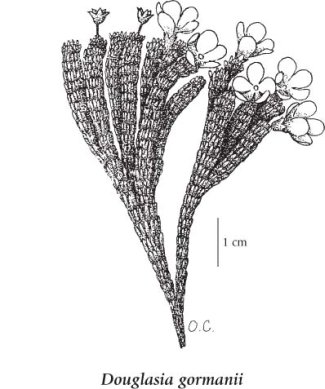Gorman's douglasia (Gorman's dwarf-primrose)
Primulaceae
Introduction to Vascular Plants
Species Information
General:
Plants densely cespitose from a branched caudex, cushion-forming, 2-5 cm tall.
Leaves:
). Leaves closely-overlapping and shingle-like along the branches, becoming marcescent with age, greenish at shoot tips and reddish-brown along the branches, linear to narrowly oblanceolate, entire, often glabrescent adaxially, hairy abaxially with stellate or forked hairs, ciliate, 4-10 mm.
Flowers:
Inflorescences of solitary (rarely 2) flowers at ends of branches, usually bracteate; involucral bract solitary (rarely absent), ovate-lanceolate, 1-2 mm. Flowers sessile; corollas rose-pink, tube 3-4 mm, lobes 3-5 mm; calyces glabrous, 3-5 mm, lobes ovate to triangular. Flowering Jun-Jul.
Fruits:
Capsules globose, 5-valvate.
Stems:
Scapes solitary at ends of branches, erect, densely hairy with branched and forked hairs, 1-3 mm (to 20 [35] mm in fruit).
Source: The Vascular Flora of British Columbia, draft 2014.
Author: Jamie Fenneman
Illustration

If more than one illustration is available for a species (e.g., separate illustrations were provided for two subspecies) then links to the separate images will be provided below. Note that individual subspecies or varietal illustrations are not always available.
Illustration Source: The Illustrated Flora of British Columbia
Ecology
The table below shows the species-specific information calculated from
original data (BEC database) provided by the BC Ministry of Forests and Range.
(Updated August, 2013)
| Site Information |
Value / Class |
||
|
Avg |
Min |
Max |
|
| Elevation
(metres) |
1790 | 1790 | 1790 |
| Slope
Gradient (%) |
65 | 65 | 65 |
|
Aspect (degrees) |
169 | 170 | 170 |
| Soil
Moisture Regime (SMR) [0 - very xeric; 4 - mesic; 8 - hydric] |
2 | 2 | 2 |
| Modal
Nutrient Regime
Class |
|||
| #
of field plots species was recorded in: |
1 | ||
| Modal
BEC Zone Class |
BAFA | ||
|
All BEC Zones (# of stations/zone) species was recorded in |
BAFA(1) | ||
|
Source:
Klinkenberg 2013
|
|||
Habitat and Range
Rocky slopes, stony tundra, and scree in the alpine zone. Rare in nw BC (Atlin, Spatsizi Plateau); north to AK, YT.Source: The Vascular Flora of British Columbia, draft 2014.
Author: Jamie Fenneman
Status Information
Synonyms
Synonyms and Alternate Names:
Douglasia arctica var. gormanii (Constance) B. Boivin
Douglasia ochotensis subsp. gormanii (Constance) A. L÷ve & D. L÷ve
Taxonomic Keys
Key to Douglasia
1a. Plants taprooted biennials, not cespitose or mat-forming; leaves in a single basal rosette…………………...…...…[D. alaskana] 1b. Plants perennials, densely to loosely cespitose from a branching caudex or rhizomatous and mat-forming; leaves in multiple rosettes or densely overlapping along the branching stems…...……………………….………………..…………...……………2 2a. Plants densely cespitose; stems densely covered in tightly overlapping, marcescent, reddish-brown leaves; plants of nw BC… ………………...............................................................................................D. gormanii 2b. Plants rhizomatous and mat-forming or loosely cespitose; leaves in multiple basal rosettes; plants of coastal BC or potentially occurring in sc or se BC..….………………………………………………...…………………………3 3a. Inflorescences of 1-2 flowers; plants loosely cespitose; not yet known from BC, but may potentially occur in extreme se interior.……………………………………………………………….[D. montana] 3b. Inflorescences of 2-10 flowers; plants usually mat-forming (sometimes loosely cespitose); plants of coastal BC or potentially occurring in sc interior……………………………………………………………………………4 4a. Leaves linear to lanceolate, densely hairy with branched and stellate hairs on both surfaces, not ciliate; plants not yet recorded from BC, but may occur in high elevation areas of the sc interior…………………....……….....[D. nivalis] 4b. Leaves oblanceolate or oblong to spatulate, glabrous on both surfaces and usually with ciliate margins; plants of coastal BC………………………………………………………………........D. laevigata
Source: The Vascular Flora of British Columbia, draft 2014 |
Taxonomic Notes
Douglasia gormanii is the only representative of a group of four densely cespitose (‘pulvinate’) Beringian Douglasia species that occurs in B.C.; the remaining three species are found in Alaska, the Yukon Territory, and extreme northeastern Siberia. Populations of D. gormanii on the Spatsizi Plateau in northwestern B.C. appear to be disjunct from the remainder of the species’ distribution, but future surveys in the remote intervening areas may yet detect additional undocumented populations; the Spatsizi Plateau is known to support other disjunct arctic-alpine species and was likely a refugium during the most recent glaciation. The pedicels of D. gormanii and related species are very short during flowering, exceeding the leaves by only a few millimetres, but elongate considerably after anthesis to become up to 3.5 cm long.
Reports of Douglasia alaskana (Cov. & Standl.) S.Kelso (ALASKA DOUGLASIA) [=Androsace alaskana Cov. & Standl.] from the Atlin region of northwestern B.C. have been based on misidentifications of D. gormanii, but this unique species occurs very close to the border in the southwest Yukon Territory and may yet be expected in the province. It is a biennial species of scree slopes and rocky alpine tundra, and is somewhat transitional morphologically between Douglasia and Androsace. Douglasia alaskana can be recognized by the single dense basal rosette of coarsely toothed leaves that subtends a dense cluster of 4-20 short-stalked pink to whitish (with age) flowers; the pedicels elongate greatly over the growing season, eventually becoming long and sprawling.
Source: The Vascular Flora of British Columbia, draft 2014 |